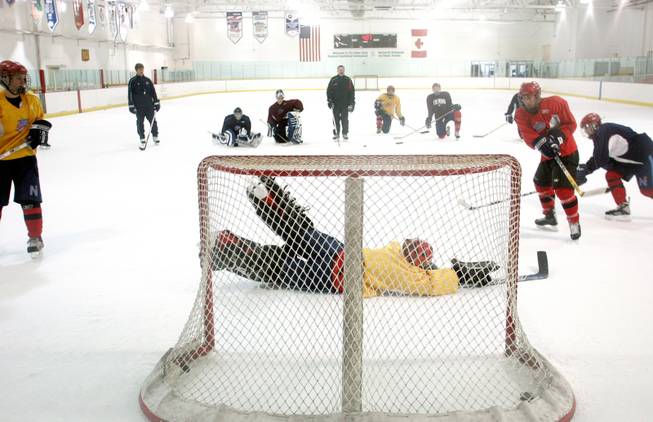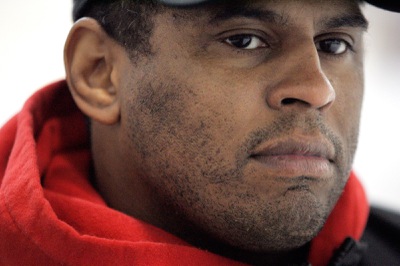Wednesday, Jan. 16, 2008 | 2 a.m.
It’s cold enough inside the Las Vegas Ice Center to see your breath as the Nevada Stars Midget 16 AAA hockey team concludes a series of excruciating wind sprints following an hourlong practice, but that doesn’t stop the sweat from cascading off the heads and faces of the 18 high school-age players as they skate off the ice.
Cody Incollingo has a pained look on his face as he reaches the bench. A visitor stops him before he can seek refuge in the locker room and asks him whether all the Stars’ practices are this tough. “Yeah,” the 16-year-old says as a big smile replaces his tortured expression. “It’s great!”
Incollingo is one of eight players on this particular Stars team one of three Midget-level teams based at the Ice Center who have come from out of state to attend school and play hockey in Las Vegas.
Why in the world would Incollingo, who is from Philadelphia, and the others leave their families and friends and come to the middle of the desert to play ice hockey?
“The exposure, I guess, is the main reason why I came here,” Incollingo says.
Tyler Wilson, a 16-year-old who moved from Alaska with his mother and older brother so he could play for the Stars, agrees with his teammate. “More tournaments, more traveling, more exposure” are what lured him to the program.
And then there are the coaches, including Eric Penn and former NHL and Las Vegas Thunder players Pokey Reddick and Rod Buskas.
“Pokey played in the NHL, so he knows what he’s doing. We’re going to get our tryouts in juniors,” Incollingo adds, referring to the various levels of organized hockey in the United States and Canada from which colleges and pro teams often recruit and draft players.
Reddick, who earned a Stanley Cup championship ring with the Edmonton Oilers in 1990, says there are several reasons parents send their kids to play hockey in Las Vegas and that his contacts in junior, collegiate and professional hockey are a benefit to players looking to move up in the sport’s ranks.
Like his teammates Incollingo and Wilson, Zachary Alvarez says his goal is to play hockey for a Division I school and he thinks playing for Reddick will give him a head start in achieving that goal.
“That’s where we (as coaches) come in, because the guys I grew up with are now the ones that are coaching D-I schools,” Reddick says. “So we make a phone call, say ‘I’ve got a kid who can play’ and if they know they’ve been taught by either Rod Buskas or myself or Eric Penn ... they’ll understand that they’ve been taught the proper things.”
Because there is a dearth of AAA teams in Southern Nevada, the Stars must travel throughout the country to play in tournaments against other top AAA teams, which also helps the Stars recruit players.
Without recruits “we would have to play AA,” Reddick says. “But in order to play against the top kids in the country, we have to play AAA, so we have to recruit about 10 kids per team so we can compete with the other top teams we play against.”
But the Nevada Stars program, which consists of an 18-and-under AAA team, an 18-and-under AA team and a 16-and-under AAA team that Reddick coaches, is not merely a hockey factory. Stars owner Kirk Brooks has set up the program much like a tennis academy, where players are home-schooled through the Odyssey Charter School. The theme of the Nevada Stars, according to Reddick, is “a lot of hockey and a lot of school.”
And a lot of structure.
The players from out of state who are home-schooled spend equal amounts of time studying, practicing and playing.
“You have to stay very disciplined because it’s home school and we all do it on our own,” says Alvarez, a 16-year-old from Sacramento, Calif. “It’s very easy to fall behind, (but Reddick) is very hard on us about it.”
The program’s emphasis on education makes it an easier sell to parents when Stars officials try to recruit a player.
“At first, they were pretty iffy about it,” Alvarez said of his parents’ reaction when he told them he wanted to come to Las Vegas to play hockey. “But then they came here and checked everything out ... and now they’re very happy with the decision they made, sending me here.”
Incollingo says his parents, both teachers, had few qualms about letting him come to Las Vegas “as long as I keep up my grades and get my education.”
“Bad grades and it’s ‘Come home,’ you know?”
Another factor that helps the Stars recruit is the cost of the program. Reddick said similar academies or prep schools with hockey programs can cost $36,000 a year. The cost of the Stars program is $10,000 to $15,000, which includes schooling, according to Reddick.
Reddick is quick to say that he and the other Stars coaches are not selling false hopes to the players or their parents.
“I want to teach them that if you don’t make it in hockey, you still have to be a good citizen,” Reddick says. “The focus for me is school first, hockey next. Kids all have dreams and I’m not here to burst their dreams we’re here to try to make them come true but if they don’t, they have their education to fall back on.”
Wilson, from Anchorage, hears what Reddick is preaching. He said his immediate goals are to play junior hockey, land a scholarship at a Division I school and then see what happens.
“Realistically, the odds of getting to the NHL are pretty small,” Wilson acknowledges, “but I want to get there. I’ve got the drive.”



Join the Discussion:
Check this out for a full explanation of our conversion to the LiveFyre commenting system and instructions on how to sign up for an account.
Full comments policy